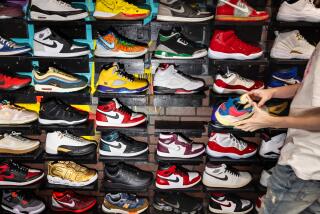In step with nature
- Share via
FOR $235 (and up!) you can buy a funny looking pair of shoes to make you stand up straight, work your “core,” elevate and shape your buttocks and, perhaps ladies, burn some extra calories to eliminate those dimpled saddlebags.
Using technology named after the Masai warriors of East Africa, who have long, lean bodies and superb posture, the shoes are meant to re-create the feel of walking barefoot for miles in desert sand.
Introduced in the U.S. three years ago, the Masai Barefoot Technology (or MBT), as the shoes are known, sport a thick, convex sole, a soft, squishy heel and -- under the arch -- a hard center.
“They actually are pretty strenuous, even just standing,” said Emily Norton, store manager of FrontRunners, a Westside fixture that sells athletic and lifestyle leisure and apparel. The shoes occupy prime real estate in the front of the store. “I’ve always had a flat butt,” Norton said, “but I’m starting to notice some differences.... I guess I’m a little shapelier.”
Physicians, perhaps not surprisingly, are skeptical of the shoes’ toning properties.
“It does exercise some of the tiny muscles in the feet,” said Dr. John Pagliano, a Long Beach-based podiatrist who specializes in sports medicine. “But you don’t really need them much. They really are just stabilizing muscles.”
But the company, MBT, is touting the body-boosting buzz and cellulite-slaying claims as it makes a push into Los Angeles’ body-conscious mainstream. After all, the must-have Ugly Chic market could be only a few celebrity photos away.
A company video shows young, beautiful people sashaying down a catwalk in MBTs; celebrity style magazines feature hot Hollywood stars spotted in the shoes; and company representatives handed out the shoes as celebrity swag on the exclusive pre-Oscar party circuit earlier this year.
The supposed wonder shoes -- and the Masai Barefoot Technology on which they’re based -- are the brainchild of Swiss engineer Karl Muller, who had long suffered back, knee and Achilles tendon problems. After spending some time walking barefoot in the rice paddies of South Korea, his pain began to subside. With the looser, pain-free gait came a eureka moment: The hard, unforgiving surfaces of modern life caused his pain. He set out to develop a shoe that emulated the soft, uneven surfaces of the natural world.
After years of research, he introduced the giant clodhoppers with the rounded rubber soles in Europe in 1996. A couple of years ago a British journalist wore them for several weeks and dubbed them “the anti-cellulite shoe.” The phrase stuck, and sales soared.
Klaus Heidegger, president of MBT, doesn’t go so far as to say the shoes will burn cellulite, but he does maintain they can help tone the body.
The shoes were introduced in the U.S. three years ago not only at orthopedic-shoe stores such as Foot Solutions, but also at high-end spas such as Bliss. The latter promotes the shoe as a sneaker for “super serious slimming.”
At FrontRunners, trained salespeople (who themselves have been trained by someone from the MBT Academy in Idaho) give customers a brief lesson in how to walk, stand and move. Each pair also comes with a half-hour DVD instructing customers on how to walk and “float” (i.e., run) in their new “physiological footwear.”
“You have to balance,” Norton said. “It helps to engage your muscles.”
Indeed, wearers can rock back and forth in the shoes in a way that could easily become an annoying habit. Norton urged caution, saying novices could potentially roll back and fall over. She also said wearers should be sure not to lock their knees when they stand still or they could strain their backs.
The shoes do seem to make wearers stand up straighter; it’s almost impossible to slouch.
“Weird,” said a potential customer, walking tentatively around the store in the shoes. “It gives me a little seasickness.”
The shoes do have some physical effect -- at least according to the studies touted on the company website. One study, conducted by the Human Performance Laboratory at the University of Calgary in Alberta, Canada, and published online last year in the journal Clinical Biomechanics, found that the shoes can reduce impact on knees and hips, easing joint pain. That study also found wearers take in 2.5% more oxygen than those walking in conventional shoes.
Similarly, researchers at Sheffield Hallam University in England found that wearing the shoes changed people’s gait. The study found that the shoes increased the activity of the buttock muscles by 9% while walking and standing, increased the activity of the rear thigh muscles by 18% and increased the muscle activity of the lower extremities by 19%.
Pagliano says he had never heard of the shoes until his college-age daughter bought a pair and they showed up on his credit card bill. He was so furious about the price he had to check them out.
The podiatrist, who is also a member of the American College of Sports Medicine, said the shoes are well-made, but dismisses most of the studies on MBTs as so small they “are really not significant.”
But the shoes are comfortable, he conceded.
Available at stores, spas and chiropractic offices throughout Southern California (www.swissmasaius.com), the shoes may have tapped into a new marketing niche.
Rebecca Runze, office administrator at the International Sportscience Institute, a chiropractic corporation in West Los Angeles, said her boss, LeRoy Perry, is designing his own shoe.
“It will still be propulsive (like the MBTs), but it will be more stable.”






